Somehow my research as a Geographer and Quaternary Scientist1 has involved me digging a lot of holes and collecting a lot of sand from deserts. However, it is not so often I get to step back and think about sand found in other environments and about the global importance of sand as a natural resource. There are some immense challenges that are starting to emerge as the result of a scarcity of sand, or at least the scarcity of the right type of sand for the enormous appetite that our society has for all of the many things that have sand as a crucial ingredient.
1 A Quaternary Scientist is someone who investigates the long term workings of,
and changes to, the environments and climate of the last 2.58 million years.
SO, WHAT IS SAND?
Sand is defined by the size of the particle (0.0625 to 2 mm in diameter) and not the composition (what it’s made up of).
Sand is most commonly made up of quartz (a form of silica) and other silicate minerals, such as feldspar and garnet, as well as bits of broken shell and coral, gypsum, volcanic glass, basalt, and other minerals. If you want to get an idea of the vast variety of types of sand, have a look at this superb Sandatlas site by Simm Sepp for lots of lovely pictures of many different types of beautiful sand. All of these particles get gradually broken down from bigger rocks (or shells etc.) through time by the action of ice, water and the wind. Most sand grains have undergone a long journey, having been through many rotations around the rock cycle.

Figure 1. Sand on the left hand side is sand from desert regions, where thousands of years of being blown around in the wind has knocked off the angular edges and rounded the grains. The less round sand on the right hand side with sharper edges is associated with being broken down by ice or water, and will have been bouncing around in the environment for a shorter amount of time (less time to smooth those edges).
Sand can be classified by shape, from spherical and smooth (left hand side in Figure 1) to more oblong and sharp (or angular) (right hand side in Figure 1).
WHAT DO WE USE SAND FOR?
Sand doesn’t just get between your toes and sneak into your bag at the beach. It has quietly (and sometimes very noisily) infiltrated into every corner of the world and our lives – many of which you might not be very aware of. What’s clear is that we can’t live without it, following the types of lives that we are living.
 For making GLASS: windowpanes, wine bottles, drinking vessels, spectacle lenses, electric cooker hobs, chopping boards, smartphone screens…
For making GLASS: windowpanes, wine bottles, drinking vessels, spectacle lenses, electric cooker hobs, chopping boards, smartphone screens…
 Within CONSTRUCTION: Sand contributes 60 % of the ingredients of reinforced concrete used for buildings (2/3rd of the world’s buildings are made of reinforced concrete) and roads (for a km of motorway, 30,000 tonnes of sand is consumed!).
Within CONSTRUCTION: Sand contributes 60 % of the ingredients of reinforced concrete used for buildings (2/3rd of the world’s buildings are made of reinforced concrete) and roads (for a km of motorway, 30,000 tonnes of sand is consumed!).

Inside our ELECTRONICS: Electronic chips use high quality sand (silica) within our computers, phones, stereos, bank cards etc.
To make FILTERS: Filtration of our water supply at sewage works uses sand, as do septic tanks and swimming pool filters.
 For SPORTS: golf bunkers might spring to mind. Maybe also beach volleyball, which requires a very specific type of sand crafted from the right range of grain sizes (it can’t have too much fine material, as it gets too stiff underfoot and players suffer injuries). For the London 2012 Olympics 2,270 tonnes of sand were delivered for the beach volleyball event (that’s 20 blue whales, or ¼ of the Eiffel Tower weight of sand!). Which other sports can you name where you see sand quite obviously? Sand is also used within some artificial turf surfaces for a wide range of sports.
For SPORTS: golf bunkers might spring to mind. Maybe also beach volleyball, which requires a very specific type of sand crafted from the right range of grain sizes (it can’t have too much fine material, as it gets too stiff underfoot and players suffer injuries). For the London 2012 Olympics 2,270 tonnes of sand were delivered for the beach volleyball event (that’s 20 blue whales, or ¼ of the Eiffel Tower weight of sand!). Which other sports can you name where you see sand quite obviously? Sand is also used within some artificial turf surfaces for a wide range of sports.
In a slightly more hidden source – within PRODUCTS: Sand is key ingredient of silicon dioxide (SiO2): a mineral found in products including wine, cleaning products, paper, dehydrated food, hairspray, toothpaste and cosmetics. Sand is in plastics, paints, tyres… The list is immense.
 And let’s revisit construction, in the context of BUILDING NEW LAND: Perhaps the most extreme example of humans using sand is the artificial sand islands that have been created out in the Persian/Arabian Gulf. For example, Palm Jumeirah cost >$12 billion and used > 150 million tonnes of sand (dredged from the coastline of Dubai). This enormous reconfiguration of land and sea seems somewhat insane, but thanks to the souring price of land in Dubai it was actually cheaper to build more land to build on than buy up what was left to build on! The madness spiralled into ‘The World’, an artificial archipelago made of sand, costing > $14 billion and using three times as much sand as the Palm. This collection of new sand islands has been almost completely abandoned since the 2008 global financial crisis, although in December 2016, there was reported progress of development on the ‘Heart of Europe’ islands. In order finish building ‘The World’ and construct the world’s largest building (Burj Khalifa) Dubai had to import sand from Australia, because they had already used up all of their suitable sand!
And let’s revisit construction, in the context of BUILDING NEW LAND: Perhaps the most extreme example of humans using sand is the artificial sand islands that have been created out in the Persian/Arabian Gulf. For example, Palm Jumeirah cost >$12 billion and used > 150 million tonnes of sand (dredged from the coastline of Dubai). This enormous reconfiguration of land and sea seems somewhat insane, but thanks to the souring price of land in Dubai it was actually cheaper to build more land to build on than buy up what was left to build on! The madness spiralled into ‘The World’, an artificial archipelago made of sand, costing > $14 billion and using three times as much sand as the Palm. This collection of new sand islands has been almost completely abandoned since the 2008 global financial crisis, although in December 2016, there was reported progress of development on the ‘Heart of Europe’ islands. In order finish building ‘The World’ and construct the world’s largest building (Burj Khalifa) Dubai had to import sand from Australia, because they had already used up all of their suitable sand!
HOW MUCH DO WE USE?
The best estimate from the United Nations is that we use around 40 billion tonnes per year. Those sorts of numbers become rather incomprehensible, even employing our Blue Whales and Eiffel Tower equivalents! (200 million Blue Whales and 5 million Eiffel Towers).
Eye-openingly, this is twice the amount of sand moved by all of the rivers of the world in one year. This makes humans the largest transforming force on the planet when it comes to shifting sediment about.
Sand is the 2nd highest used raw material on Earth, and that’s a second only to water! We use at least 5 times more sand than we use coal every year.
 And the point to shout about, to anyone that will listen, is that we are using sand far far far more quickly than it is getting replenished (naturally produced within the environment). We are mining it unsustainably, and there are vast environmental consequences!
And the point to shout about, to anyone that will listen, is that we are using sand far far far more quickly than it is getting replenished (naturally produced within the environment). We are mining it unsustainably, and there are vast environmental consequences!
WHERE DO WE GET OUR SAND FROM?
So where is all of that sand coming from? And this is where I learn that the beautiful seas of sands within deserts2 should be safer for a little longer.
2It has been found that desert sand is not actually the right kind of sand for
much of human usage. It is too smooth and too round for construction, it doesn’t
stick together. It is so smooth and round because as the wind blows the sand
around in the desert, the sharp edges are knocked off. In water there is a very
fine film of water, which reduces the amount the grains rub against each other
and removing the sharper edges. How round a grain of sand gets also depends on the
amount of time it has been moving around since it was eroded from a larger piece
of rock (shell, coral, etc.).
Initially most sand came from quarries, just like the sand quarries that are found close to the BlueDot festival site here in Cheshire, and dredged from rivers. However, as demand has increases there has been a huge shift to:
- coastal beach deposits (LH side below)
- dredging sand from the ocean floor (RH side below)
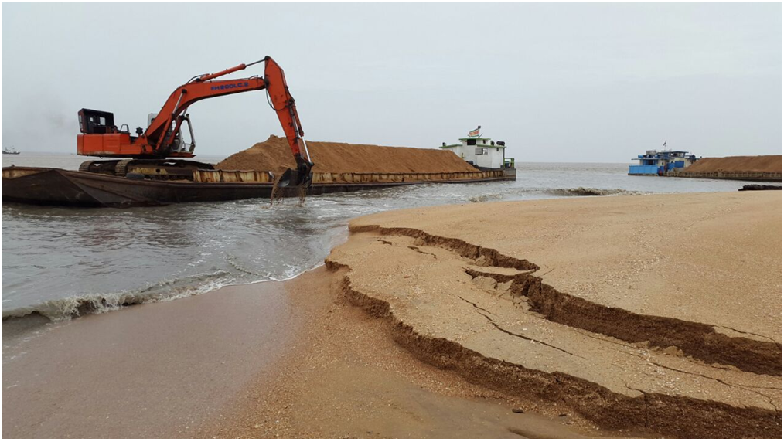
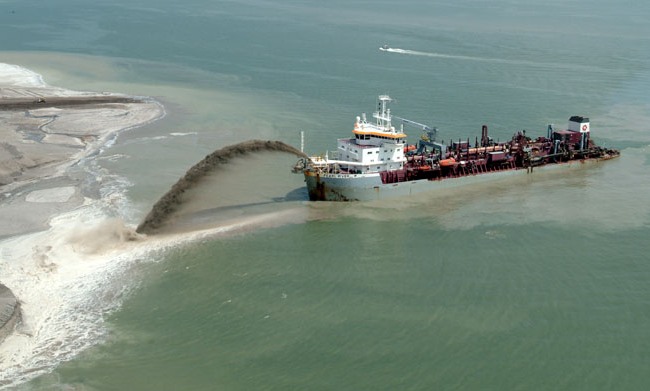
ENVIRONMENTAL CONSEQUENCES OF THE GLOBAL APPETITE FOR SAND
There consequences of removing 40 billion tonnes of sand per year and turning it into built urban infrastructure, and new islands, and billions of products, is that the size of the land that was made of sand is decreasing in extent. That means disappearing beaches, or whole islands. That means increased erosion in rivers, leading to bridges being undermined. That means shrinking deltas. That means huge disruption on the sea bed from mining via sand dredging. That means losses of river, delta and marine habitats and ecosystems.
DEADLY WARS AND SAND MAFIAS!
Placing restrictions of the extraction of sand has led to an extensive underground network of criminal activity. Criminals, illegally digging up, transporting and selling sand. In India, the ‘sand mafia’ controls an illicit marker of a head-scratching $2.3 billion per year!
https://blogs.wsj.com/indiarealtime/2013/08/06/why-india-has-a-sand-mafia/
http://www.abc.net.au/news/2017-03-28/the-great-sand-heist-fuelling-india-120-billion-building/8390984
SAVE OUR SAND – WHAT ARE THE ALTERNATIVES?
Building using recycled concrete materials and also using more wood, bamboo and straw.
Increased rates of recycling of sand-rich products, such as sand.
We can even produce sand for construction from recycling glass!
Ultimately in a world run by profit and large corporations, perhaps the Placing a higher cost on sand, and incorporating the environmental costs, as a disincentive to its over-mining. But, as we see from the sand mafias, this just pushes the problem into the non-formal sector. So it looks like we need a more fundamental shift in the sands, and that is a shift away from the reliance of modern society on sand!
So. Please.
Go shout about sand!
Even for a minute or two. Talk to your family, your neighbours, your friends. There is a huge gulf (of missing sand) between the huge size of the problem of over-mining the Earth’s sand and the size of the public awareness of the problem(s) (and the size of these beautiful tiny particles).
—–
To learn more, watch Sand Wars, a film by Denis Delestrac. http://sand-wars.com/


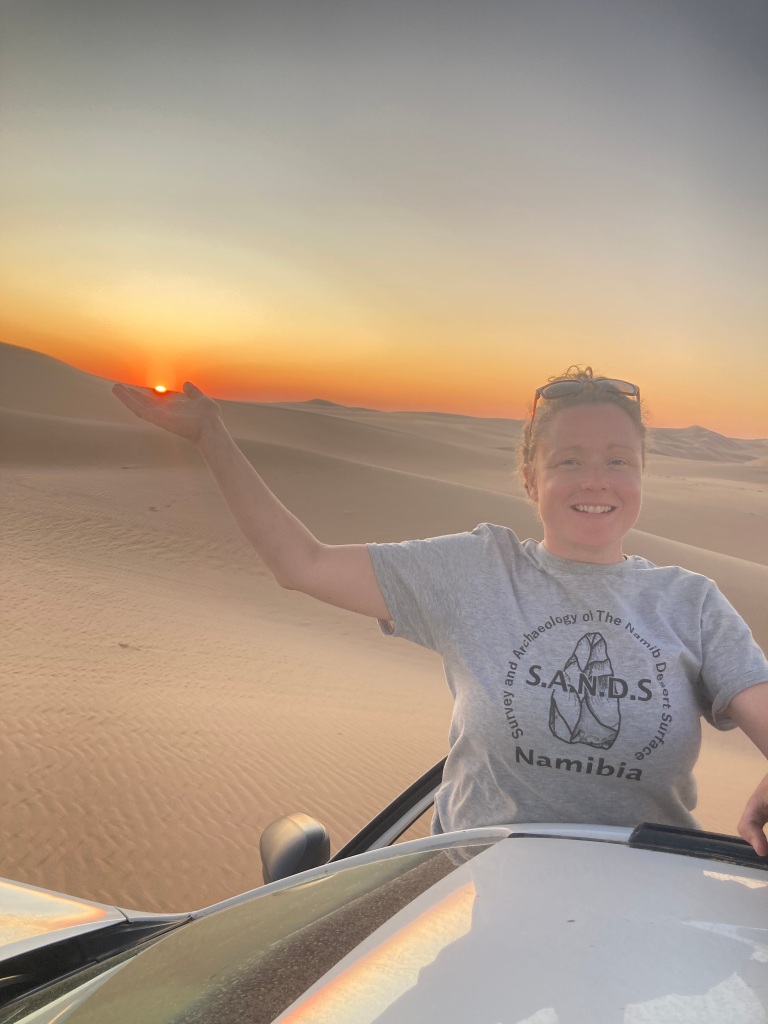
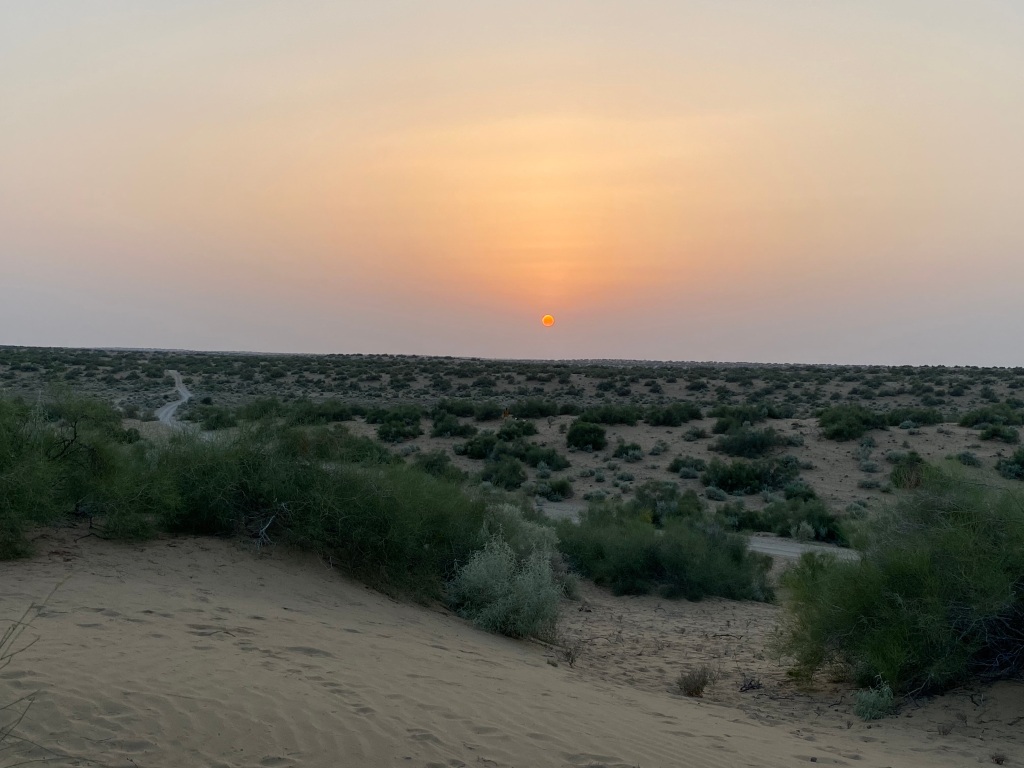







 And the point to shout about, to anyone that will listen, is that we are using sand far far far more quickly than it is getting replenished (naturally produced within the environment). We are mining it unsustainably, and there are vast environmental consequences!
And the point to shout about, to anyone that will listen, is that we are using sand far far far more quickly than it is getting replenished (naturally produced within the environment). We are mining it unsustainably, and there are vast environmental consequences!



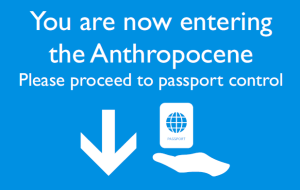
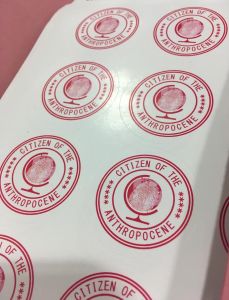


 ere they are originating from. From an assessment of the setting itself, we suggested in 2014 that a natural origin was most likely. The land-owner in this region does not add any fertilisers to the land and uses the land for low density sheep grazing. We considered that a source from the sheep (their urine and faeces) was unlikely, owing to (i) the sampled sites being well away from animal enclosures and (ii) the depth of elevated nitrate within the profile representing accumulation of nitrate over a timescale of decades. It seems too improbable that a sheep, or collection of sheep, would select a 10 to 20 cm diameter target on the top of one dune as a long-term latrine! Our most probable explanation remains a source from N-fixing vegetation. In the Kalahari, such N-fixing forms of vegetation include Acacia trees and grasses (such as Stipagrostis amabalis, Schmidtia kalihariensis and Arstida congesta). Whilst the sites we sampled are not close to Acacia trees, there are some grass species present.
ere they are originating from. From an assessment of the setting itself, we suggested in 2014 that a natural origin was most likely. The land-owner in this region does not add any fertilisers to the land and uses the land for low density sheep grazing. We considered that a source from the sheep (their urine and faeces) was unlikely, owing to (i) the sampled sites being well away from animal enclosures and (ii) the depth of elevated nitrate within the profile representing accumulation of nitrate over a timescale of decades. It seems too improbable that a sheep, or collection of sheep, would select a 10 to 20 cm diameter target on the top of one dune as a long-term latrine! Our most probable explanation remains a source from N-fixing vegetation. In the Kalahari, such N-fixing forms of vegetation include Acacia trees and grasses (such as Stipagrostis amabalis, Schmidtia kalihariensis and Arstida congesta). Whilst the sites we sampled are not close to Acacia trees, there are some grass species present.




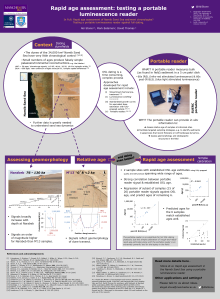

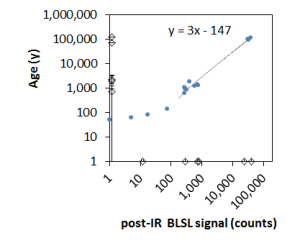

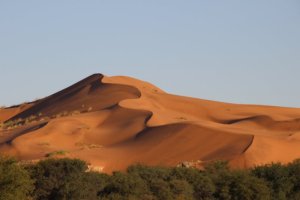
 (Top, or LH side) Northern Namib Sand Sea dune, with green ribbon of trees in the Kuiseb River valley in the foreground (taken by Abi at the Gobabeb Research Centre). (bottom or RH side) Camel v. tank. Are these two of the popular images that spring to mind when you hear ‘desert’ or ‘dryland’. (U.S. Army photo by Sgt. Marcus Fichti; Creative Commons license)
(Top, or LH side) Northern Namib Sand Sea dune, with green ribbon of trees in the Kuiseb River valley in the foreground (taken by Abi at the Gobabeb Research Centre). (bottom or RH side) Camel v. tank. Are these two of the popular images that spring to mind when you hear ‘desert’ or ‘dryland’. (U.S. Army photo by Sgt. Marcus Fichti; Creative Commons license) If you want to read something to whet your appetite whilst deciding whether you’d like to choose this option, Nick Middleton (presenter of ‘Going to Extremes’) has written an excellent little book ‘Deserts: A Very Short Introduction’.
If you want to read something to whet your appetite whilst deciding whether you’d like to choose this option, Nick Middleton (presenter of ‘Going to Extremes’) has written an excellent little book ‘Deserts: A Very Short Introduction’.